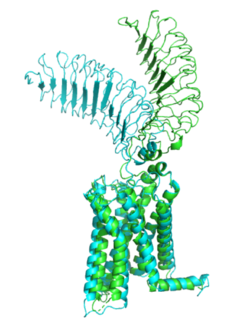Sandbox Reserved 1780
From Proteopedia
(Difference between revisions)
| Line 3: | Line 3: | ||
<StructureSection load= <StructureSection load='Edited_7utz.pse' size='340' side='right' caption='Thyroid stimulating hormone receptor bound to thyroid stimulating hormone' scene='95/952708/Tshr_general_structure/3'> | <StructureSection load= <StructureSection load='Edited_7utz.pse' size='340' side='right' caption='Thyroid stimulating hormone receptor bound to thyroid stimulating hormone' scene='95/952708/Tshr_general_structure/3'> | ||
== Active and Inactive Form == | == Active and Inactive Form == | ||
| - | The TSHR protein exists in two states, active and inactive. The <scene name='95/952708/Tshr_chainr_ecd/1'>extracellular domain (ECD)</scene> sticks out from the cell membrane into the space outside the cell. The <scene name='95/952708/Tshr_chainr_tm/1'>transmembrane domain</scene> contains 7 alpha helices that reside within the cell membrane. The <scene name='95/952708/Tshr_chainr/4'>TSHR active form</scene> exists when bound to the thyroid stimulating hormone (TSH) | + | The TSHR protein exists in two states, active and inactive. The <scene name='95/952708/Tshr_chainr_ecd/1'>extracellular domain (ECD)</scene> sticks out from the cell membrane into the space outside the cell. The <scene name='95/952708/Tshr_chainr_tm/1'>transmembrane domain</scene> contains 7 alpha helices that reside within the cell membrane. The <scene name='95/952708/Tshr_chainr/4'>TSHR active form</scene> exists when bound to the thyroid stimulating hormone (TSH). One proposed mechanism for the transition from the active to inactive describes that in its natural state, the TSHR ECD can spontaneously transition to the up state, leading to constitutive activity. In this active state, TSH will bind and keep the active state in the up position because of clash with the cell membrane.<ref name="Duan et al."> DOI:10.1038/s41586-022-05159-1</ref> Conformational change of ECD allows for signal transduction through the TM and into the cell. |
Revision as of 20:44, 20 March 2023
| This Sandbox is Reserved from February 27 through August 31, 2023 for use in the course CH462 Biochemistry II taught by R. Jeremy Johnson at the Butler University, Indianapolis, USA. This reservation includes Sandbox Reserved 1765 through Sandbox Reserved 1795. |
To get started:
More help: Help:Editing |
| |||||||||||
References
- ↑ Faust B, Billesbolle CB, Suomivuori CM, Singh I, Zhang K, Hoppe N, Pinto AFM, Diedrich JK, Muftuoglu Y, Szkudlinski MW, Saghatelian A, Dror RO, Cheng Y, Manglik A. Autoantibody mimicry of hormone action at the thyrotropin receptor. Nature. 2022 Aug 8. pii: 10.1038/s41586-022-05159-1. doi:, 10.1038/s41586-022-05159-1. PMID:35940205 doi:http://dx.doi.org/10.1038/s41586-022-05159-1

